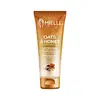What's inside
What's inside
 Key Ingredients
Key Ingredients

No key ingredients
 Benefits
Benefits

 Concerns
Concerns

 Ingredients Side-by-side
Ingredients Side-by-side

Water
Skin ConditioningPropanediol
SolventCetyl Alcohol
EmollientDiheptyl Succinate
EmollientCapryloyl Glycerin/Sebacic Acid Copolymer
Skin ConditioningCetearyl Alcohol
EmollientBehentrimonium Chloride
PreservativePPG-3 Benzyl Ether Myristate
EmollientGlycerin
HumectantParfum
MaskingAvena Sativa Seed Extract
Skin ConditioningHydroxyethylcellulose
Emulsion StabilisingCetrimonium Chloride
AntimicrobialHoney
HumectantPhenoxyethanol
PreservativeBenzoic Acid
MaskingEthylhexylglycerin
Skin ConditioningGlycereth-2 Cocoate
EmulsifyingDipropylene Glycol
HumectantWater, Propanediol, Cetyl Alcohol, Diheptyl Succinate, Capryloyl Glycerin/Sebacic Acid Copolymer, Cetearyl Alcohol, Behentrimonium Chloride, PPG-3 Benzyl Ether Myristate, Glycerin, Parfum, Avena Sativa Seed Extract, Hydroxyethylcellulose, Cetrimonium Chloride, Honey, Phenoxyethanol, Benzoic Acid, Ethylhexylglycerin, Glycereth-2 Cocoate, Dipropylene Glycol
Water
Skin ConditioningCetyl Alcohol
EmollientPolycitronellol T-Butyl Ether
EmollientIsopentyldiol
HumectantBehentrimonium Methosulfate
Butyrospermum Parkii Butter
Skin ConditioningIsoamyl Laurate
EmollientC10-18 Triglycerides
EmollientIsodecyl Oleate
EmollientGlycol Stearate
EmollientBeta Vulgaris Root Extract
Skin ConditioningDiheptyl Succinate
EmollientGlyceryl Ricinoleate
EmollientLinoleamidopropyl Dimethylamine Dimer Dilinoleate
Skin ConditioningGlycerin
HumectantButylene Glycol
HumectantHydrolyzed Corn Starch
HumectantCapryloyl Glycerin/Sebacic Acid Copolymer
Skin ConditioningPropanediol
SolventCaprylyl Glycol
EmollientRicinus Communis Seed Oil
MaskingEthyl Lauroyl Arginate Hcl
Skin ConditioningHydroxyacetophenone
AntioxidantHydroxyethylcellulose
Emulsion StabilisingParfum
MaskingLimonene
PerfumingHexyl Cinnamal
PerfumingLinalool
PerfumingCitronellol
PerfumingWater, Cetyl Alcohol, Polycitronellol T-Butyl Ether, Isopentyldiol, Behentrimonium Methosulfate, Butyrospermum Parkii Butter, Isoamyl Laurate, C10-18 Triglycerides, Isodecyl Oleate, Glycol Stearate, Beta Vulgaris Root Extract, Diheptyl Succinate, Glyceryl Ricinoleate, Linoleamidopropyl Dimethylamine Dimer Dilinoleate, Glycerin, Butylene Glycol, Hydrolyzed Corn Starch, Capryloyl Glycerin/Sebacic Acid Copolymer, Propanediol, Caprylyl Glycol, Ricinus Communis Seed Oil, Ethyl Lauroyl Arginate Hcl, Hydroxyacetophenone, Hydroxyethylcellulose, Parfum, Limonene, Hexyl Cinnamal, Linalool, Citronellol
Ingredients Explained
These ingredients are found in both products.
Ingredients higher up in an ingredient list are typically present in a larger amount.
We don't have a description for Capryloyl Glycerin/Sebacic Acid Copolymer yet.
Cetyl Alcohol is a fatty alcohol. Fatty Alcohols are most often used as an emollient or to thicken a product.
Its main roles are:
Though it has "alcohol" in the name, it is not related to denatured alcohol or ethyl alcohol.
The FDA allows products labeled "alcohol-free" to have fatty alcohols.
Learn more about Cetyl AlcoholWe don't have a description for Diheptyl Succinate yet.
Glycerin is already naturally found in your skin. It helps moisturize and protect your skin.
A study from 2016 found glycerin to be more effective as a humectant than AHAs and hyaluronic acid.
As a humectant, it helps the skin stay hydrated by pulling moisture to your skin. The low molecular weight of glycerin allows it to pull moisture into the deeper layers of your skin.
Hydrated skin improves your skin barrier; Your skin barrier helps protect against irritants and bacteria.
Glycerin has also been found to have antimicrobial and antiviral properties. Due to these properties, glycerin is often used in wound and burn treatments.
In cosmetics, glycerin is usually derived from plants such as soybean or palm. However, it can also be sourced from animals, such as tallow or animal fat.
This ingredient is organic, colorless, odorless, and non-toxic.
Glycerin is the name for this ingredient in American English. British English uses Glycerol/Glycerine.
Learn more about GlycerinHydroxyethylcellulose is used to improve the texture of products. It is created from a chemical reaction involving ethylene oxide and alkali-cellulose. Cellulose is a sugar found in plant cell walls and help give plants structure.
This ingredient helps stabilize products by preventing ingredients from separating. It can also help thicken the texture of a product.
This ingredient can also be found in pill medicines to help our bodies digest other ingredients.
Learn more about HydroxyethylcelluloseParfum is a catch-all term for an ingredient or more that is used to give a scent to products.
Also called "fragrance", this ingredient can be a blend of hundreds of chemicals or plant oils. This means every product with "fragrance" or "parfum" in the ingredients list is a different mixture.
For instance, Habanolide is a proprietary trade name for a specific aroma chemical. When used as a fragrance ingredient in cosmetics, most aroma chemicals fall under the broad labeling category of “FRAGRANCE” or “PARFUM” according to EU and US regulations.
The term 'parfum' or 'fragrance' is not regulated in many countries. In many cases, it is up to the brand to define this term.
For instance, many brands choose to label themselves as "fragrance-free" because they are not using synthetic fragrances. However, their products may still contain ingredients such as essential oils that are considered a fragrance by INCI standards.
One example is Calendula flower extract. Calendula is an essential oil that still imparts a scent or 'fragrance'.
Depending on the blend, the ingredients in the mixture can cause allergies and sensitivities on the skin. Some ingredients that are known EU allergens include linalool and citronellol.
Parfum can also be used to mask or cover an unpleasant scent.
The bottom line is: not all fragrances/parfum/ingredients are created equally. If you are worried about fragrances, we recommend taking a closer look at an ingredient. And of course, we always recommend speaking with a professional.
Learn more about ParfumPropanediol is an all-star ingredient. It softens, hydrates, and smooths the skin.
It’s often used to:
Propanediol is not likely to cause sensitivity and considered safe to use. It is derived from corn or petroleum with a clear color and no scent.
Learn more about PropanediolWater. It's the most common cosmetic ingredient of all. You'll usually see it at the top of ingredient lists, meaning that it makes up the largest part of the product.
So why is it so popular? Water most often acts as a solvent - this means that it helps dissolve other ingredients into the formulation.
You'll also recognize water as that liquid we all need to stay alive. If you see this, drink a glass of water. Stay hydrated!
Learn more about Water